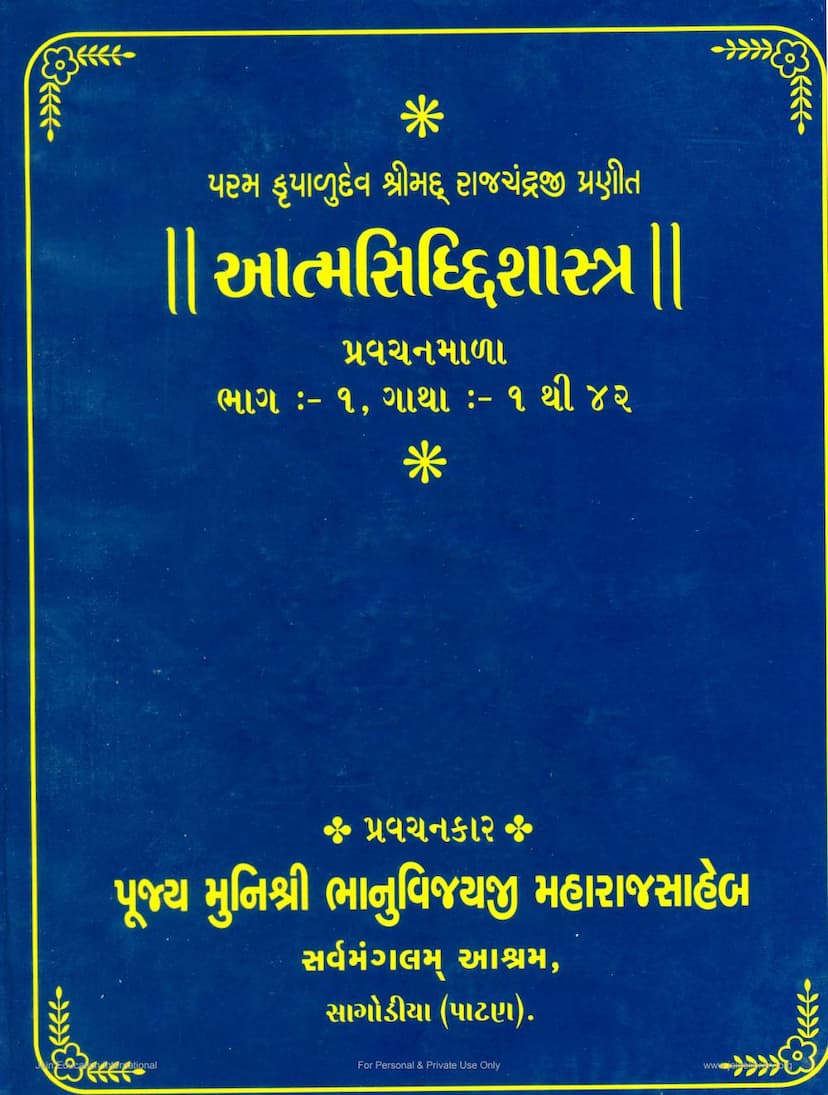Atmasiddhishastra Part 01
Added to library: September 1, 2025

Summary
This document is a collection of discourses on Shrimad Rajchandra's Atmasiddhishastra, delivered by Pujya Munishri Bhanuvijayji Maharaj. This "Bhag 1" covers verses 1 to 42 of the scripture. The discourses were compiled by Sadhvi Divyadarshitaji Maharaj and Shrimati Bharatiji Niranjanbhai Mehta, and published by Sadhrut Abhyas Vartul.
The text begins with introductory pages, including dedications and publisher information, followed by a biographical note on Shrimad Rajchandra, highlighting his influence on Mahatma Gandhi. The preface, penned by Prof. Dr. Sagarmalji Jain, emphasizes that Atmasiddhishastra is not merely a written text but a revealed scripture, born from Shrimad Rajchandra's spiritual realizations. It notes the profound depth of the text and the insightful explanations provided by Munishri Bhanuvijayji Maharaj, making it an essential guide for spiritual seekers.
The discourses then delve into the teachings, chapter by chapter (or verse by verse), covering a wide range of topics central to Jain philosophy and spiritual practice:
Core Themes and Concepts Discussed:
- The Nature of Suffering and its Cause: The discourses identify ignorance of the true self (Atman) as the root cause of infinite suffering, emphasizing that the soul is eternal and not bound by birth or death.
- The Existence and Nature of the Soul (Atman): The text asserts the reality of the soul, its eternal nature, its role as the doer and experiencer of karma, and the possibility of liberation (moksha).
- The Role of the Sadguru: A significant emphasis is placed on the indispensability of a Sadguru, who is described as the true guide to understanding the soul and the path to liberation. The discourses outline the characteristics of a true guru, emphasizing their experiential knowledge and spiritual authority over mere scriptural knowledge.
- The Importance of Viveka and Discrimination: The need to differentiate between the eternal self (Atman) and the transient material world (pudgal) is highlighted. This understanding is crucial for spiritual progress.
- The Distinction Between the Real and the Unreal: The text explores how worldly possessions, body, and even worldly achievements are ultimately impermanent and distinct from the true self.
- The Limitations of External Rituals and Scholastic Knowledge: The discourses caution against being merely "kriyajad" (bound by rituals without inner understanding) or a "shushkgyani" (one with dry, unapplied knowledge). True spiritual progress comes from inner transformation and experiential realization.
- The Significance of Vairagya and Tyaga: Detachment and renunciation are presented not as the end goal, but as essential steps and aids towards attaining self-knowledge.
- The Concept of Maya and its Illusory Nature: The text discusses how worldly illusions (maya) create attachment and prevent the soul from recognizing its true nature.
- The Paths to Liberation (Moksha): The discourses explain that liberation is not achieved through mere intellectual understanding or external rituals, but through the integration of knowledge, conduct, and detachment, guided by the Sadguru.
- The Importance of Inner Transformation: The core message emphasizes inner purity, mental tranquility, and the purification of consciousness as the path to realizing the soul's true nature.
- The Four Hindrances to Spiritual Progress: The text identifies four primary obstacles: svachhanda (self-will, independent action without proper guidance), matagraha (attachment to one's own views and doctrines), mān (ego), and alobha (desire for worldly gains). Overcoming these is crucial for spiritual advancement.
- The Nature of Self-Realization: The ultimate goal is described as the direct experience of the soul, a state of pure consciousness, bliss, and eternal peace, attained through sincere devotion, contemplation, and the guidance of a Sadguru.
Structure and Style:
The discourses are presented in a devotional and accessible style, aiming to explain the profound spiritual concepts of Atmasiddhishastra in a way that is relatable to the common person. Munishri Bhanuvijayji Maharaj's explanations are lauded for their simplicity, clarity, and the use of practical examples. The text also includes a detailed appendix with a glossary of Gujarati terms used in the discourses, aiding comprehension.
Overall Purpose:
The overarching purpose of this work is to illuminate the path to self-realization and spiritual liberation as expounded by Shrimad Rajchandra and expounded by Munishri Bhanuvijayji. It serves as a spiritual compass, guiding the reader towards understanding the true nature of the soul and the practical steps required for its liberation from the cycle of birth and death. The emphasis is on the internal transformation and the living experience of spirituality, rather than mere intellectual understanding or outward observance.